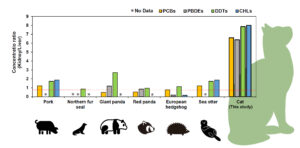卒室生である佐藤里菜さんのデータが論文になりました!
卒室生である佐藤里菜さんのデータが論文になりました!
ネコは異物代謝能が低く、有害化学物質への曝露とその影響が懸念されています。本研究では、ネコの残留性有機汚染物質(POPs)の組織分布を解析し、初めて他の哺乳類に比べてネコが腎臓中にPOPsを高蓄積することを明らかにしました。このネコの特異なPOPsの腎集積が、ネコに多い慢性腎臓病に関連する可能性を示しました。
これまでの動物実験では、腎臓中のPOPsが尿細管上皮細胞の壊死や脱落を引き起こすことが報告されています。しかし、ネコでは尿細管に蓄積した死細胞を除去するアポトーシス阻害剤(AIM)が発動しないため、POPs蓄積による尿細管に蓄積した死細胞を除去できないため、急性または慢性腎臓病に陥る可能性があることを指摘しました。論文は以下のリンクから50日間(6月13日まで)どなたでもダウンロードできます。
Data from graduate student Rina Sato has been published in a paper!
Cats have a low capacity to metabolize harmful substances, and exposure to toxic chemicals and their effects are of concern. In this study, we analyzed the tissue distribution of persistent organic pollutants (POPs) in cats and found, for the first time, that cats accumulate higher levels of POPs in their kidneys than other mammals. This unique renal accumulation of POPs in cats may be related to chronic kidney disease, which is common in cats.
Previous animal studies have reported that POPs in the kidney cause necrosis of tubular epithelial cells. However, we found that in cats, the apoptosis inhibitor of macrophages (AIM), which removes dead cells accumulated in the tubules, is not triggered, and therefore the dead cells accumulated in the tubules due to POPs accumulation cannot be removed, which may lead to acute or chronic kidney disease.
Please use ‘Share Link’ – the following personalized URL providing 50 days’ free access to the above article.

